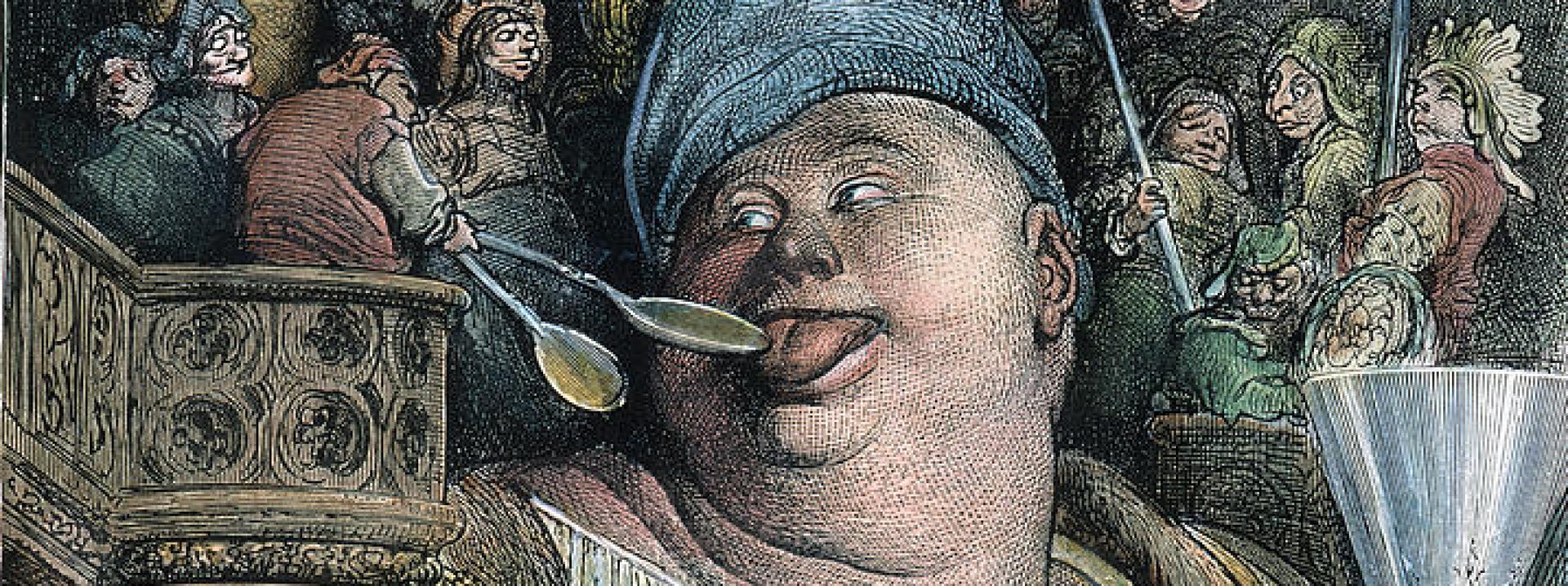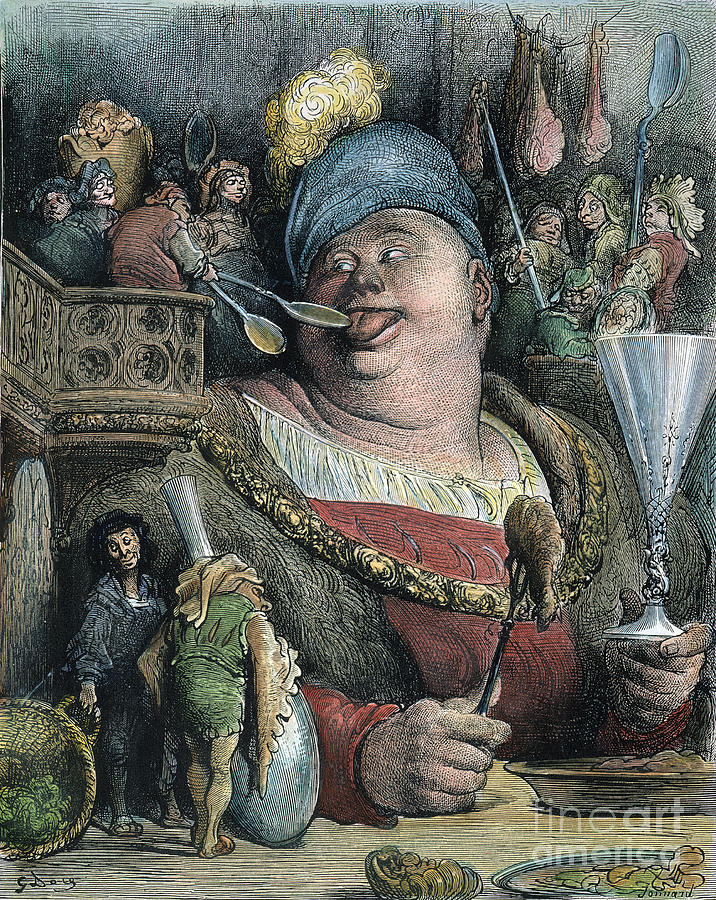It’s time to start considering your plans for the final project. First, read over the new instructions here. Decide whether to take the Critical or Creative approach, and settle on a plan.
- Critical
- What Bakhtin will you read?
- What will you use it to interpret?
- Creative
- What text or author will you chose as your model?
- What will your new creation be?
Post a very brief description of your idea below. Please post here by 5pm on Tuesday, 4/21. This is instead of your daily Reading Diary post; you only need to post in the Reading Diary on Monday and Wednesday this week.


For my final project, I plan to do a creative project on one of the books Pantagruel finds in the library of Saint-Victor, The Pomegranate of Vices. It will be an excerpt of the book and play on the myth of Persephone eating the pomegranate and the grotesque idea of over-abundance/gluttony.
Sounds wonderful, Alice! What an evocative title!
For my final project, I am also completing the creative option. I want to write a chapter (or fragment of a chapter) for Satyrica that explores themes of the sacred and grotesque. This will be a story that discovers the sacred in a grotesque body, specifically a body that is perceived by characters in Greco-Roman society as divine but by Bakhtin as grotesque. This chapter will also be semi-reminiscent of the scene with the child of Mercury and Venus in Fellini-Satyricon.
I like your thinking, Elinor! It sounds like you have a clear sense of the themes you’d like to explore, so I’ll look forward to seeing how that ends up embodied in a narrative (pun intended).
I plan to do the critical essay option, looking at Bakhtin 254-277 and Aristophanes’ Clouds (which we didn’t read but I think interfaces with the concept of the carnivalesque). I am particularly interested in the problem of seriousness, truth, and foolishness in Bakhtin’s conception of the carnivalesque, and Clouds, a comedy which centers conflict between two competing philosophies presented explicitly *as* capital-p philosophies (and perhaps my favorite Aristophanes play), could speak to those issues in enriching ways.
Sounds great, Helena! It’s one of the key moments in Bakhtin’s work, and I think you’re right that Clouds will be an excellent place to explore the question of seriousness. Looking forward to your thoughts!
At the end of Pantagruel we are told that he has more adventures, yet none of them are ever written about. I will be creating the story of “how he visited the regions of the moon to learn whether the moon is in truth not whole because women have three of its quarters in their heads.”
Sounds great, Liam! One of Rabelail’s chief classical models was Lucian’s Vera Historia (or “True Story”), which (among other adventures) does actually involve a journey to the moon. You might glance at a summary just to see how the theme is handled there. Looking forward to reading this story!
For my final project, I’ll be completing the reflective essay option, using part one Bakhtin’s chapter five (315-41) on the distinctions between grotesque and classical bodies. My essay will examine the ways that Bakhtin’s assessment of Pantagruel as the quintessential grotesque body and that body as one that violates classical standards of size holds up to more contemporary fat studies work, as seen in the Fat Studies Reader. Specifically, I want to look at the way that contemporary fat bodies are dismissed as grotesque based on physical size as an extension of Bakhtin’s analysis: while Pantagruel’s grotesque nature lies in both his size and behavior, today’s fatphobia prevails based largely on judgements of physical scale alone.
Sounds wonderful, Allison, and I’m glad you’ll be bringing Fat Studies back into the conversation. The entire Reader is available online (see links under Resources), in case you want to review or read further there, though of course that’s not required. Looking forward to seeing your conclusions!
I plan to explore the use of the vernacular in Rabelais in Pantagruel alongside Bakhtin pg. 456-74. I absolutely love language/etymology and am interested in how Rabelais pulled the vernacular into a literary work, and how Bakhtin allows us to understand better the effect of Rabelais’s more common language (especially as it often occurs alongside some more educated jokes) on his contemporaries.
Sounds great, Hannah! I think you’ll find this is one of the places where Bakhtin becomes most, shall we say, lyrical in his appreciation of Rabelais, and seems almost to argue that Rabelais work approaches the sublime. I’ll be very curious to see what you make of it!
I plan to do the critical essay option, examining Fellini-Satyricon alongside Bakhtin’s Chapter 6 (pg 377-400), which deals with hell and the underworld as the focus of Grotesque degradation. In particular, I want to focus on Bakhtin’s discussion of how nature and the elements interact with and are represented in the human body, and how this is used for degradation in Fellini-Satyricon.
Sounds wonderful, Sophia! Many people have read Encolpius’ experiences at Trimalchio’s as a journey into Hell (a kind of darkened maze, guarded by a dog, where various mythological persons are exhibited, with finally a funeral and an escape over a river, etc etc); I’m looking forward to seeing how you read Bakhtin’s discussion against the film version. Great idea!
I’m planning to complete the critical essay option examine banquet imagery in pantagruel. I’m interested in the depictions of abundance and consumption that we’ve encountered throughout the semester.
Sounds good, Chloe! Bakhtin sees eating as perhaps the most central carnivalesque act, so it’s a great thing to focus your thinking around.
For the final project, I choose to do a creative project and write a missing chapter for Pantagruel’s adventure. It will be a chapter on Pantagruel’s trip to the land of dwarf. In this chapter, I am going to focus on the grotesque bodies and the carnivalesque eternity of the crowd.
Sounds great, Eve! I’ll be looking forward to seeing how you use opposite extremes of the human form to explore these ideas.
I plan to read “Popular-Festive Forms and Images in Rabelais – part 1” which discusses violence in the Carnival. I then will apply this to parts of the Satyrica, especially the feast, to help find why the Satyrica is not as Carnivalesque and explain how it differs from Bakhtin’s ideal.
Sounds great, Nico – you’ll be answering a question that’s been troubling me as well (and one that I honestly didn’t anticipate becoming quite so central before our semester began), so I’m very much looking forward to reading your thoughts!
I’m planning on doing the critical essay option using Bakhtin’s chapter 5, which looks at the grotesque body. I want to examine Oliver Twist (particularly the character of Fagin), and how the grotesque body plays a role in both the novel and the 1948 film. I’m interested to look at how the grotesque has been used in other works of fiction and how it can be used to “other” people and reinforce social hierarchies.
I plan on doing the critical essay option. I will use Bakhtin 145-167 to examine the dialogue in Henry IV. I’m specifically interested in Bakhtin’s view of billingsgate and in which contexts it’s used or acceptable.
Didn’t mean for this to be a reply ^^ oh well!
Jake, this idea sounds excellent! I’m glad you’ll be bringing Henry IV back into the conversation; some wonderful billingsgate there, that we just didn’t have enough time to really explore!
Charlotte, this sounds great! If you weren’t a part of Allison’s Appetizer group from a couple of weeks ago, you might take a look back at that conversation about the grotesque in anti-semitism. Either way, I’ll be excited to see how you build on those thoughts in your analysis!
For a critical approach to Bakhtin, I will be using his writing on praise-abuse in Rabelais’ novel to better understand the Stephan Elliott’s 1994 Australian film. “The Adventures of Priscilla, Queen of the Desert.” The plot follows three drag performers who take a road trip into the desolate outback. I’m interested in studying the use of language among the three main characters and with those around them. How are bonds of affection maintained with language? Does the carnivalesque atmosphere of drag hieghten or lower tensions? I think that this film will be an especially rich source thanks to the abundance of grotesquely degrading words and phrases in Australian English.
This sounds so wonderful, Collin! It’s one of my favorite movies, so I’ll be very curious to see what you make of it; I think you’re right to sense that there’s a great deal of the carnivalesque in the world of drag and the relationships among the characters.
I plan on completing the critical essay option utilizing Bakhtin’s Chapter 5 on the distinction between the classical and grotesque body in Pantagruel. I want to look at the relationship between the actual bodies in the text and their effect on the environment.
This sounds great, Hannah! To keep your thinking focused, I would recommend pairing the Bakhtin excerpt with something specific we’ve looked at in class or that you know well, so that you can try out Bakhtin’s ideas for a specific analysis. Looking forward to seeing what you come up with!
For my final project I’ll do the first option with a comparison of chapter 6 part 1 about images of the lower stratum and how it’s expressed in the dialogue/visual within the Fellini Satryicon movie. I will include some comparison to the Satryica. Specifically, a comparison of dialogue and what’s shown.
Sounds wonderful, Tia! It’s a key moment in Bakhtin’s work, so I’ll look forward to seeing how you use it to explore either the text or film of Satyrica, or both!